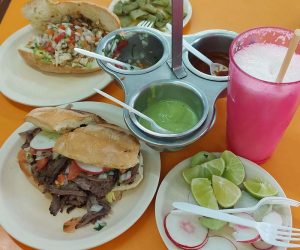Ever since returning from Mexico, I’ve been exploring Calgary for great taco joints across the city. Although none quite compare with the street taco experience, I was able to find a few places that offered fairly authentic experiences for Mexican street food. Paired with a fruity, tropical drink, tacos make the perfect finger food or main course. When I was in Mexico, I noticed that there are various different fillings for tacos based on the location.
Tacos are a blend of ancient Mexican recipes and international influences. Indigenous people in Mexico ate a version of tacos that looked slightly different. The fillings were filled with fish and other cooked organs. Authentic taco-stands in Mexico sold tacos with beef tongue, intestines and more. Cheese, lettuce, sour cream and tomato were a future addition.
When I first arrived in Mexico, I knew few words in Spanish. Ordering was tricky because the different Spanish terms referred to the fillings in the taco. So of course, I had to try them all to understand which was my favorite.

This is the Mexican restaurant I tried in Calgary. The affair was fancier and the food was delicious. But the spices were quite unlike the street tacos I’ve had. The flavors are less pungent and salsas less spicy.
Carne Asada
In English this translates to grilled meat. Carne Asada is typical in north states. The meat is juicy and spiced with cumin, lime and thinly sliced. I love that the flavors are soaked into the pork making it extra flavorful and juicy.
Taco de pescado
Fish tacos are found on the menu in many places. In Canada, you might find them even at fast food places. The fish taco originates in Baja, California, which is a strip that is south of California. The fish is a boneless, fried fillet and topped with coleslaw and mayonnaise. The fish taco was not something I had tried on this trip, but was something I fell in love with on my trip to San Diego. Authentic fish tacos in the Yucatan area were rare and likely didn’t taste quite like the Fillet-O-Fish type varieties in south California.
Al pastor
This is the most famous of the taco flavors everywhere I went in the Yucatan area. When I tried to Google Translate this one, it would refer to the “pastor” which didn’t give me a clue as to what it entailed. After trying this flavor, I found that it was a slow cooked pork that was on a rotating spit. Similar to that of donair joints in Canada, the meat is cooked in open flame and well-charred, giving a delicious grilled taste to the meat. The locals had multiple DIY toppings available but traditional Al pastor is topped with pineapple, which gives the taco a tangy taste.
Tacos de Birria
Birria originated in the Western Mexican state of Jalisco. Birria is essentially a spicy meat stew slow cooked to perfection. Usually, it’s prepared with goat that is marinated in a chili broth. Birria tacos are popular, but the Birria filling can be consumed by itself and is a popular dish served during special occasions. Birria has other varieties, including beef.

Campechanos tacos on the side of the street. Perfectly spiced and toped with green chilli, salsa and cilantro.
Campechanos
When I was ordering from street vendors in Mexico, this was by far my favorite item on the menu. This is a taco variety originating in the southern states of Campeche (hence the name Campechanos). It is made with a medley of meats including sausage, thinly sliced beef, chorizo and is both spicy, crunchy, and savory. The flavors were explosive.



